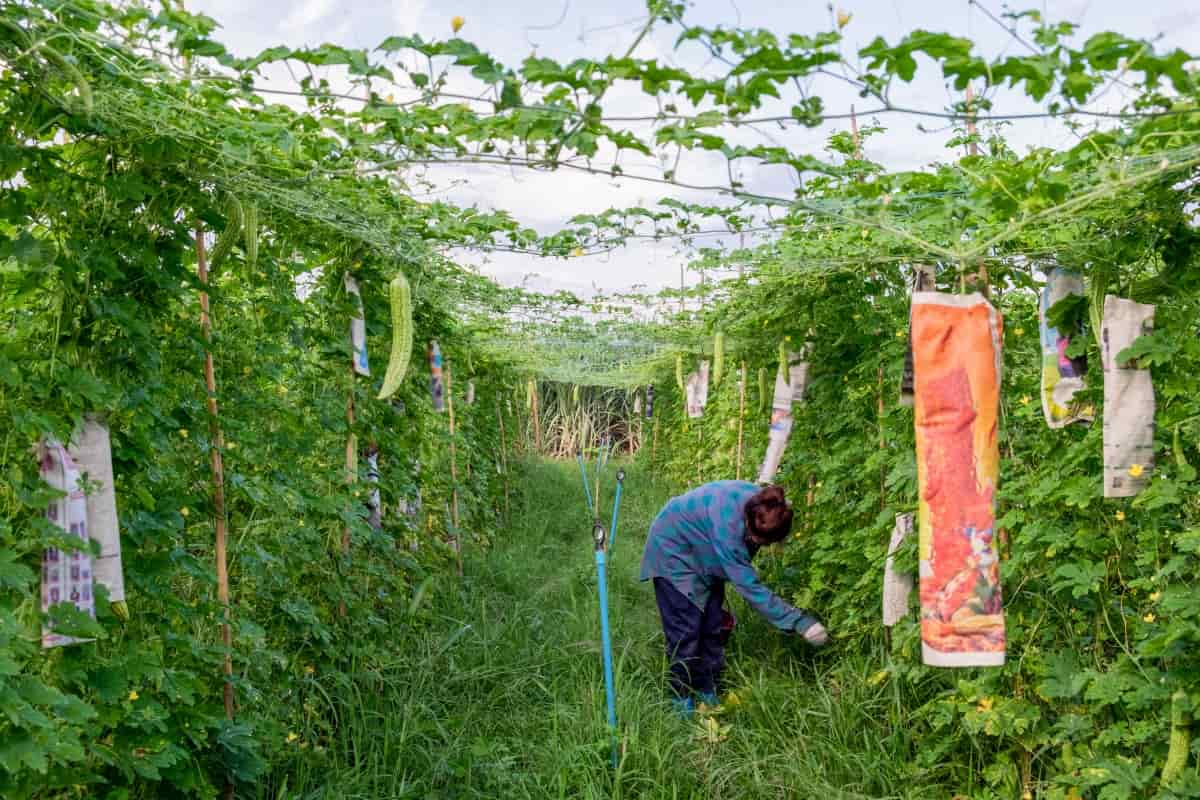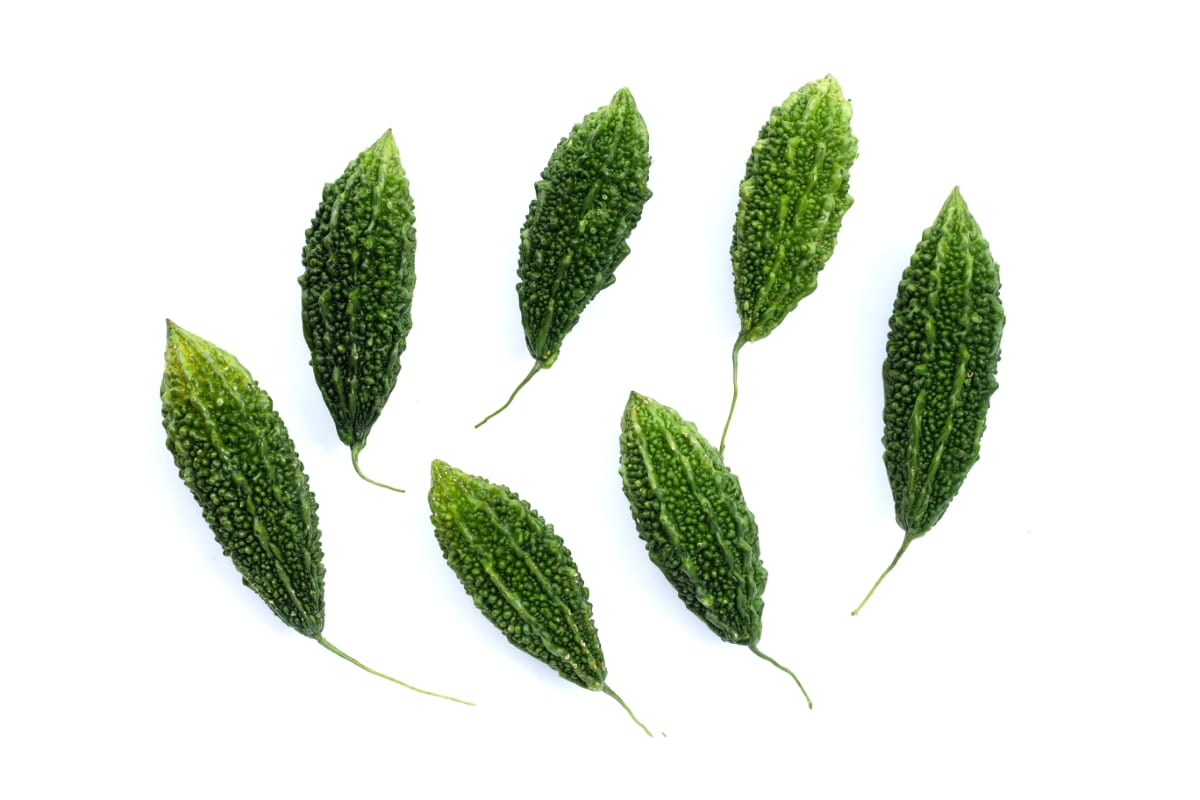Bitter Gourd, scientifically known as Momordica charantia, is a popular vegetable crop cherished for its distinctive bitter taste. However, like any other plant, it is vulnerable to various diseases and pests. The most common problem faced by Bitter Gourd growers is the Leaf Curl Virus. Leaf Curl Virus in Bitter Gourd refers to a viral infection that affects the leaves of the plant. Therefore, implementing effective treatment and control methods becomes crucial in ensuring successful cultivation.

Leaf Curl Virus in Bitter Gourd
Understanding Leaf Curl Virus in Bitter Gourd
Identifying Symptoms and Signs: The first indicators of the Leaf Curl Virus are the curling and distortion of leaves. Infected plants may also exhibit stunted growth, with smaller and fewer fruits being produced. Another sign to look out for is the presence of whitefly infestations. Whiteflies are insects that feed on plant sap and can transmit the Leaf Curl Virus from infected plants to healthy ones.
How the Virus Affects Bitter Gourd Plants: The virus is primarily transmitted through insect vectors such as whiteflies, which feed on the sap of infected Bitter Gourd plants and then transfer the virus to healthy ones. Once infected, Bitter Gourd plants start showing visible symptoms of leaf curling, yellowing or mottling of leaves, stunted growth, and reduced fruit production. Infected plants are often unsuitable for sale in markets due to their distorted appearance and poor taste quality.
Preventive Measures Against Leaf Curl Virus
Selecting Resistant Varieties: When choosing resistant Bitter Gourd varieties, it is crucial to consider their performance and adaptability in your specific growing conditions. Some popular resistant Bitter Gourd varieties include ‘Karela 1’, ‘Priya,’ ‘Green Gold,’ and ‘Suruchi.’ These varieties not only exhibit resistance against the Leaf Curl Virus but also offer other desirable characteristics like good fruit quality and high yields.
Implementing Crop Rotation and Field Hygiene: Crop rotation involves alternating Bitter Gourd with non-host plants such as legumes or grains. These crop rotations help break the disease cycle by depriving the virus-carrying insects of their preferred host plant. Field hygiene practices such as removing infected plant debris after harvest, cleaning tools and equipment thoroughly before moving to a new field, and eradicating weeds that may serve as alternate hosts are essential for preventing disease spread.
Diagnosis and Detection Techniques
Visual Inspection for Early Detection: During visual inspection, farmers should look out for distinct leaf curling and yellowing, which are common indicators of the Leaf Curl Virus. Other symptoms may include stunted growth, distorted leaves, and reduced fruit production. They can provide valuable insights into distinguishing the Leaf Curl Virus from other similar diseases or disorders that might affect Bitter Gourd plants.
Laboratory Testing for Accurate Diagnosis: One common method is enzyme-linked immunosorbent assay (ELISA), which detects viral proteins in plant tissues. This test provides reliable results and helps confirm whether or not your plants are infected. Another useful tool is polymerase chain reaction (PCR), a molecular technique that amplifies specific DNA sequences of the virus. It’s important to note that laboratory testing must be conducted by trained professionals who follow proper protocols and use well-maintained equipment.
Cultural Management Practices
Optimal Plant Spacing and Pruning: Proper plant spacing is essential to ensure good air circulation between plants. It is recommended to space Bitter Gourd plants at least 2-3 feet apart, allowing ample room for their growth and preventing overcrowding. Pruning also plays a vital role in managing Leaf Curl Virus. Regularly remove any infected or diseased leaves from the plants as soon as they are noticed. This helps prevent further virus spread and allows healthy foliage to grow.
Proper Irrigation and Fertilization Techniques: Adequate water supply and balanced nutrient levels are essential for maintaining the overall plant health, making them less susceptible to viral infections. In terms of fertilization, a balanced approach is key. Use a slow-release organic fertilizer or compost that provides a steady release of nutrients over time.
In case you missed it: How to Pollinate Bitter Gourd: Hand Pollination, Pollination Methods, and Tips

Biological Control Methods
Utilizing Beneficial Insects
Ladybugs, also known as lady beetles, are one such beneficial insect that can help control aphids, which transmit the Leaf Curl Virus. These colorful little bugs have voracious appetites and can devour large numbers of aphids in a short period. Other beneficial insects are the lacewing and parasitic wasps. Utilizing beneficial insects not only helps control pest populations but also reduces reliance on chemical pesticides that may harm other non-target organisms or contaminate water sources.
Natural Predators and Biological Agents
Lacewings are the best natural predators, and they feed on a variety of pests, including whiteflies, which are also known to transmit the Leaf Curl Virus. Encouraging lacewings to establish a presence in your garden can significantly decrease whitefly populations and limit virus transmission. The best biological agent is Trichoderma spp., a fungus that is used as a biocontrol agent against plant diseases, including viral infections like Leaf Curl Virus.
Chemical Control Strategies
Appropriate Use of Insecticides
Before using any insecticide, it is important to identify the specific pest causing the problem. Different pests require different types of insecticides for effective control. Therefore, proper diagnosis and identification are essential. It is important to read and follow all instructions on the product label to ensure effective application.
Fungicides and Virucides for Virus Control
Some commonly used fungicides for virus control in Bitter Gourd include copper-based products, sulfur-based products, and systemic fungicides like azoxystrobin. These chemicals work by reproduction of fungal pathogens responsible for transmitting the leaf curl virus. Virucides are also effective in managing viral infections in Bitter Gourd plants.
Integrated Pest Management (IPM)
Combining Cultural, Biological, and Chemical Controls
Cultural controls play an important role in IPM by creating unfavorable conditions for pests. This includes proper crop rotation, which helps break pest life cycles, and field hygiene practices, such as removing plant debris to reduce pest populations. Biological controls involve using natural predators and parasites to keep pest populations in check. Chemical controls should be used judiciously as a last resort when other methods fail. In IPM, it’s important to choose pesticides that specifically target the pests without harming beneficial organisms.
Monitoring and Threshold Levels for Pest Control
Regular monitoring allows growers to detect the presence of pests or signs of infection early on, enabling prompt action to prevent spread and damage. By establishing threshold levels based on population densities or severity of symptoms, growers can determine when intervention measures are necessary.
Controlling the Whitefly Vector
Methods to Reduce Whitefly Population
Whiteflies are tiny insects that can wreak havoc on your Bitter Gourd plants by transmitting the leaf curl virus. Preventing these pests from infesting your crops is crucial for successful cultivation. Keep a close eye on your plants for any signs of whiteflies. Early detection allows for prompt action, preventing further spread of the pests. Hang yellow sticky traps around your garden to attract and catch adult whiteflies in large numbers, reducing their population significantly over time.
Understanding Whitefly Behavior and Lifecycle
To effectively control the spread of the leaf curl virus in Bitter Gourd plants, it is crucial to gain a deeper understanding of the behavior and lifecycle of its primary vector, the whitefly. By knowing how these tiny insects operate, we can implement targeted methods to reduce their population and prevent further transmission of the virus.
In case you missed it: 7 Common Problems with Bitter Melon/Bitter Gourd Plants: Treatment and Solutions

The life cycle of a whitefly consists of several stages: egg, nymph, pupa, and adult. Adult female whiteflies lay eggs on the leaf underside, where they remain until they hatch into nymphs. The nymphs then go through molts before reaching adulthood. This entire process takes roughly three weeks under optimal conditions.
Recovery and Care of Affected Plants
Techniques for Reviving Infected Plants
Remove any severely affected or dead plant parts. This will prevent the virus spread and allow the healthy parts of the plant a chance to thrive. Pruning is also recommended to promote new growth and rejuvenation. Additionally, consider using foliar sprays with natural ingredients such as neem oil or garlic extract. These have been found effective in reducing viral infection symptoms while protecting against further infestation.
Long-Term Care and Monitoring
Regularly inspect your plants for any signs or symptoms of infection. Remove and destroy any affected leaves or plant parts to prevent further spread of the virus. Maintaining good field hygiene is also important in preventing the recurrence of the Leaf Curl Virus. Practice proper crop rotation by avoiding planting Bitter Gourd in the same area year after year. This helps disturb the disease cycle and reduces the likelihood of re-infection.
In case you missed it: 10 Best Bitter Gourd Varieties for High Production/Yield

Conclusion
This viral infection can cause significant damage to Bitter Gourd plants if left untreated. Infected plants exhibit distinct symptoms such as curling and crinkling of leaves, stunted growth, yellowing or mosaic patterns on leaves, and reduced yield quality. Controlling the Leaf Curl Virus in Bitter Gourd is crucial for maintaining healthy crops and maximizing yields.
- Feed Your Flock for Less: Top 10 Tips to Save on Chicken Feed
- Ultimate Guide to Ossabaw Island Hog: Breeding, Raising, Diet, and Care
- Hatching Answers: The Top 10 Reasons Your Chickens Aren’t Laying Eggs
- Eggs and Economics: Breaking Down the Cost of Raising Backyard Chickens
- Defend Your Greens: Proven Methods to Keep Iguanas Out of Your Garden
- Ultimate Guide to Cinnamon Queen Chicken: A Comprehensive Guide for Beginners
- Ultimate Guide to California Tan Chicken: Breeding, Raising, Diet, Egg-Production and Care
- Ultimate Guide to Marsh Daisy Chicken: Breeding, Raising, Diet, and Care
- 10 Types of Chicken Farming Businesses You Can Start for Profits